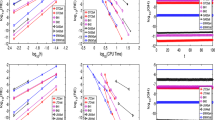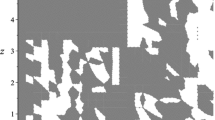Abstract
We rigorously study a novel type of trigonometric Fourier collocation methods for solving multi-frequency oscillatory second-order ordinary differential equations (ODEs) \(q^{\prime \prime }(t)+Mq(t)=f(q(t))\) with a principal frequency matrix \(M\in \mathbb {R}^{d\times d}\). If \(M\) is symmetric and positive semi-definite and \(f(q) = -\nabla U(q)\) for a smooth function \(U(q)\), then this is a multi-frequency oscillatory Hamiltonian system with the Hamiltonian \(H(q,p)=p^{T}p/2+q^{T}Mq/2+U(q),\) where \(p = q'\). The solution of this system is a nonlinear multi-frequency oscillator. The new trigonometric Fourier collocation method takes advantage of the special structure brought by the linear term \(Mq\), and its construction incorporates the idea of collocation methods, the variation-of-constants formula and the local Fourier expansion of the system. The properties of the new methods are analysed. The analysis in the paper demonstrates an important feature, namely that the trigonometric Fourier collocation methods can be of an arbitrary order and when \(M\rightarrow 0\), each trigonometric Fourier collocation method creates a particular Runge–Kutta–Nyström-type Fourier collocation method, which is symplectic under some conditions. This allows us to obtain arbitrary high-order symplectic methods to deal with a special and important class of systems of second-order ODEs in an efficient way. The results of numerical experiments are quite promising and show that the trigonometric Fourier collocation methods are significantly more efficient in comparison with alternative approaches that have previously appeared in the literature.






Similar content being viewed by others
References
L. Brugnano and F. Iavernaro. Line integral methods which preserve all invariants of conservative problems. J. Comput. Appl. Math. 236 (2012), 3905–3919.
L. Brugnano, F. Iavernaro and D. Trigiante. A note on the efficient implementation of Hamiltonian BVMs. J. Comput. Appl. Math. 236 (2011), 375–383.
L. Brugnano, F. Iavernaro and D. Trigiante. A simple framework for the derivation and analysis of effective one-step methods for ODEs. Appl. Math. Comput. 218 (2012), 8475–8485.
L. Brugnano, F. Iavernaro and D. Trigiante. Energy and Quadratic Invariants Preserving integrators based upon Gauss collocation formulae. SIAM J. Numer. Anal. 50 (2012), 2897–2916.
R.W. Butler and A.T.A. Wood. Laplace approximations for hypergeometric functions with matrix argument. Ann. Statist. 30 (2002), 1155–1177.
E. Celledoni, R.I. McLachlan, B. Owren and G.R.W. Quispel. Energy-Preserving Integrators and the Structure of B-series. Found. Comput. Math. 10 (2010), 673–693.
P. Chartier and A. Murua. Preserving first integrals and volume forms of additively split systems. IMA J. Numer. Anal. 27 (2007), 381–405.
J.L. Cieslinski and B. Ratkiewicz. Energy-preserving numerical schemes of high accuracy for one-dimensional Hamiltonian systems. J. Phys. A: Math. Theor. 44 (2011), 155206.
D. Cohen. Conservation properties of numerical integrators for highly oscillatory Hamiltonian systems. IMA J. Numer. Anal. 26 (2006), 34–59.
D. Cohen and E. Hairer. Linear energy-preserving integrators for Poisson systems. BIT 51 (2011), 91–101.
D. Cohen, E. Hairer and C. Lubich. Numerical energy conservation for multi-frequency oscillatory differential equations. BIT 45 (2005), 287–305.
D. Cohen, T. Jahnke, K. Lorenz and C. Lubich. Numericalintegrators for highly oscillatory Hamiltonian systems: a review, inAnalysis, Modeling and Simulation of Multiscale Problems (A. Mielke,ed.). Springer, Berlin (2006), 553–576.
M. Dahlby, B. Owren and T. Yaguchi. Preserving multiple first integrals by discrete gradients. J. Phys. A: Math. Theor. 44 (2011), 305205.
J.M. Franco. Runge-Kutta-Nyström methods adapted to the numerical integration of perturbed oscillators. Comput. Phys. Comm. 147 (2002), 770–787.
J.M. Franco. Stability of explicit ARKN methods for perturbed oscillators. J. Comput. Appl. Math. 173 (2005), 389–396.
J.M. Franco. New methods for oscillatory systems based on ARKN methods. Appl. Numer. Math. 56 (2006), 1040–1053.
A. García, P. Martín and A.B. González. New methods for oscillatory problems based on classical codes. Appl. Numer. Math. 42 (2002), 141–157.
B. García-Archilla, J.M. Sanz-Serna and R.D. Skeel. Long-time-step methods for oscillatory differential equations. SIAM J. Sci. Comput. 20 (1999), 930–963.
R. Gutiérrez, J. Rodriguez and A.J. Sáez. Approximation of hypergeometric functions with matricial argument through their development in series of zonal polynomials. Electron. Trans. Numer. Anal. 11 (2000), 121–130.
E. Hairer. Energy-preserving variant of collocation methods. JNAIAM J. Numer. Anal. Ind. Appl. Math. 5 (2010), 73–84.
E. Hairer and C. Lubich. Long-time energy conservation of numerical methods for oscillatory differential equations. SIAM J. Numer. Anal. 38 (2000), 414–441.
E. Hairer, C. Lubich and G. Wanner. Geometric Numerical Integration: Structure-Preserving Algorithms for Ordinary Differential Equations. 2nd edn. Springer-Verlag, Berlin, Heidelberg, 2006.
E. Hairer, R.I. McLachlan and R.D. Skeel. On energy conservation of the simplified Takahashi-Imada method. Math. Model. Numer. Anal. 43 (2009), 631–644.
E. Hairer, S.P. Nørsett and G. Wanner. Solving OrdinaryDifferential Equations I: Nonstiff Problems. Springer-Verlag,Berlin, 1993.
J.K. Hale. Ordinary Differential Equations. Roberte E. Krieger Publishing company, Huntington, New York, 1980.
M. Hochbruck and C. Lubich. A Gautschi-type method for oscillatory second-order differential equations. Numer. Math. 83 (1999), 403–426.
M. Hochbruck and A. Ostermann. Explicit exponential Runge-Kutta methods for semilineal parabolic problems. SIAM J. Numer. Anal. 43 (2005), 1069–1090.
M. Hochbruck and A. Ostermann. Exponential integrators. Acta Numer. 19 (2010), 209–286.
M. Hochbruck, A. Ostermann and J. Schweitzer. Exponential rosenbrock-type methods. SIAM J. Numer. Anal. 47 (2009), 786–803.
F. Iavernaro and B. Pace. Conservative Block-Boundary Value Methods for the solution of Polynomial Hamiltonian Systems. AIP Conf. Proc. 1048 (2008), 888–891.
F. Iavernaro and D. Trigiante. High-order symmetric schemes for the energy conservation of polynomial Hamiltonian problems. JNAIAM J. Numer. Anal. Ind. Appl. Math. 4 (2009), 787–101.
A. Iserles. A First Course in the Numerical Analysis of Differential Equations. 2nd edn. Cambridge University Press, Cambridge, 2008.
A. Iserles, G.R.W. Quispel and P.S.P. Tse. B-series methods cannot be volume-preserving. BIT 47 (2007), 351–378.
A. Iserles and A. Zanna. Preserving algebraic invariants with Runge-Kutta methods. J. Comput. Appl. Math. 125 (2000), 69–81.
P. Koev and A. Edelman. The efficient evaluation of the hypergeometric function of a matrix argument. Math. Comput. 75 (2006), 833–846.
M. Leok and T. Shingel. Prolongation-collocation variational integrators. IMA J. Numer. Anal. 32 (2012), 1194–1216.
J. Li, B. Wang, X. You and X. Wu. Two-step extended RKN methods for oscillatory systems. Comput. Phys. Comm. 182 (2011), 2486–2507.
J. Li and X. Wu. Adapted Falkner-type methods solving oscillatory second-order differential equations. Numer. Algo. 62 (2013), 355–381.
R.I. McLachlan, G.R.W. Quispel and P.S.P. Tse. Linearization-preserving self-adjoint and symplectic integrators. BIT 49 (2009), 177–197.
M. Petkovšek, H.S. Wilf and D. Zeilberger. A=B, AK Peters Ltd., Wellesley, MA, 1996.
G.R.W. Quispel and D.I. McLaren. A new class of energy-preserving numerical integration methods. J. Phys. A 41 (2008), 045206.
E.D. Rainville. Special functions. Macmillan, New York, 1960.
S. Reich. Symplectic integration of constrained Hamiltonian systems by composition methods. SIAM J. Numer. Anal. 33 (1996), 475–491.
S. Reich. On higher-order semi-explicit symplectic partitioned Runge-Kutta methods for constrained Hamiltonian systems. Numer. Math. 76 (1997), 231–247.
D.S.P. Richards. High-Dimensional Random Matrices from the Classical Matrix Groups, and Generalized Hypergeometric Functions of Matrix Argument. Symmetry 3 (2011), 600–610.
J.M. Sanz-Serna. Symplectic integrators for Hamiltonian problems: an overview. Acta Numer. 1 (1992), 243–286.
C.W. Scherr and E.V. Ivash. Associated Legendre Functions. Am. J. Phys. 31 (1963), 753.
L.J. Slater. Generalized hypergeometric functions. Cambridge University Press, Cambridge, 1966.
Sun Geng. Construction of high order symplectic Runge-Kutta methods. J. Comput. Math. 11 (1993), 250–260.
P.J. Van der Houwen and B.P. Sommeijer. Explicit Runge-Kutta (-Nyström) methods with reduced phase errors for computing oscillating solutions. SIAM J. Numer. Anal. 24 (1987), 595–617.
H. Van de Vyver. A fourth-order symplectic exponentially fitted integrator. Comput. Phys. Comm. 174 (2006), 115–130.
B. Wang, K. Liu and X. Wu. A Filon-type asymptotic approach to solving highly oscillatory second-order initial value problems. J. Comput. Phys. 243 (2013), 210–223.
B. Wang and X. Wu. A new high precision energy-preserving integrator for system of oscillatory second-order differential equations. Phys. Lett. A 376 (2012), 1185–1190.
B. Wang, X. Wu and H. Zhao. Novel improved multidimensional Strömer-Verlet formulas with applications to four aspects in scientific computation. Math. Comput. Modell. 57 (2013), 857–872.
K. Wright. Some relationships between implicit Runge-Kutta, collocation and Lanczos \(\tau \) methods, and their stability properties. BIT 10 (1970), 217–227.
X. Wu and B. Wang. Multidimensional adapted Runge-Kutta-Nyström methods for oscillatory systems. Comput. Phys. Comm. 181 (2010), 1955–1962.
X. Wu, B. Wang and W. Shi. Efficient energy-preserving integrators for oscillatory Hamiltonian systems. J. Comput. Phys. 235 (2013), 587–605.
X. Wu, B. Wang and J. Xia. Explicit symplectic multidimensional exponential fitting modified Runge-Kutta-Nyström methods. BIT 52 (2012), 773–795.
X. Wu, X. You, W. Shi and B. Wang. ERKN integrators for systems of oscillatory second-order differential equations. Comput. Phys. Comm. 181 (2010), 1873–1887.
X. Wu, X. You and B. Wang. Structure-Preserving Algorithms for Oscillatory Differential Equations. Springer-Verlag, Berlin, Heidelberg, 2013.
X. Wu, X. You and J. Xia. Order conditions for ARKN methods solving oscillatory systems. Comput. Phys. Comm. 180 (2009), 2250–2257.
Acknowledgments
Bin Wang and Xinyuan Wu were supported in part by the Natural Science Foundation of China under Grants 11271186 and 11401333, by NSFC and RS International Exchanges Project under Grant 113111162, by the Specialized Research Foundation for the Doctoral Program of Higher Education under Grant 20130091110041, by the 985 Project at Nanjing University under Grant 9112020301, by A Project Funded by the Priority Academic Program Development of Jiangsu Higher Education Institutions, by the Natural Science Foundation of Shandong Province under Grant ZR2014AQ003. Bin Wang is sincerely thankful to Numerical Analysis Group at University of Cambridge since the work was partly done when he was studying in this group as a visiting student. The revised version of the manuscript was completed during Bin Wang and Xinyuan Wu were visiting to Numerical Analysis Group at University of Cambridge in July and August, 2014. The authors are sincerely thankful to two anonymous reviewers for their valuable suggestions, which help improve the presentation of the manuscript significantly.
Author information
Authors and Affiliations
Corresponding author
Additional information
Communicated by Hans Munthe-Kaas.
Appendices
Appendix 1: Proof of Theorem 4.3
By virtue of Lemma 4.1, (27) and (28), one has
\(\square \)
Appendix 2: Proof of Theorem 4.4
From \(Q(\mathbf {y})=q^TDp\) and \(D^T=-D\), it follows that
Since \(q^TD(f(q)-Mq)=0\) for any \(q\in \mathbb {R}^{d}\), we obtain
\(\square \)
Rights and permissions
About this article
Cite this article
Wang, B., Iserles, A. & Wu, X. Arbitrary-Order Trigonometric Fourier Collocation Methods for Multi-Frequency Oscillatory Systems. Found Comput Math 16, 151–181 (2016). https://doi.org/10.1007/s10208-014-9241-9
Received:
Revised:
Accepted:
Published:
Issue Date:
DOI: https://doi.org/10.1007/s10208-014-9241-9
Keywords
- Second-order ordinary differential equations
- Multi-frequency oscillatory systems
- Trigonometric Fourier collocation methods
- Multi-frequency oscillatory Hamiltonian systems
- Quadratic invariant
- Variation-of-constants formula
- Symplectic methods




